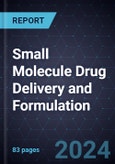Disruptive Technologies Drive Growth Opportunities for New Product Launches
Small molecules, which are the leading drug class across indications, face several issues that threaten their drug delivery efficacy. They suffer from off-target effects, poor bioavailability, low solubility, systemic toxicity, and poor permeability. While the small molecule drug development pipeline remains a leading therapeutic class, it is essential to intensify R&D to improve drug delivery approaches. This analysis of the latest advances in small molecule drug delivery covers developments in organic, inorganic, and carrier-free small molecule drug delivery systems (DDSs) as well as developments in formulations for improved patient adherence and targeted small molecule delivery.
Small molecule drug modification approaches - such as the modification of functional groups, masking undesirable chemical groups, and conjugation of targeting ligands - remain a widespread method for drug delivery. However, other approaches are emerging, including prodrug strategies, small molecule-drug conjugates (SMDCs), and multivalent delivery systems, which serve to modify the drug and achieve desirable drug properties - higher solubility and bioavailability and better targeted delivery.
As advanced technology platforms for the development of novel DDSs emerge, new small molecule DDSs experience more widespread adoption. Development has accelerated for lipid-based, polymer-based, and dendrimer DDSs. These improve the sustained release and target specificity of small molecules. For instance, cancer cells are specifically targeted using improved versions of the existing delivery systems and newer delivery systems.
Emerging smart and programmable stimuli-response delivery systems are industry-disrupting technologies that can use any type of carrier for targeted and sustained small molecule drug release. Nanocarriers and nanoformulations are a key industry trend across all delivery vehicle types under development for multiple indications. Naturally derived carriers - such as exosomes and blood components - are under research for their biocompatibility and biodegradability properties. Lipid-based carriers lead in the oral formulations segment, especially for small hydrophobic molecules. Carrier-free self-assembly nanodrugs are emerging as the next generation of small molecule drugs.
These new developments and approaches in formulations help improve patient adherence. Dry powder inhalable formulations for cancer and pulmonary diseases increase the bioavailability of small molecule drugs and patient adherence, especially in comparison to injectables. Oral formulations and injectables remain one of the most widely adopted modes of administration for cancer and neurological and pulmonary diseases, while the sublingual mode is under exploration.








